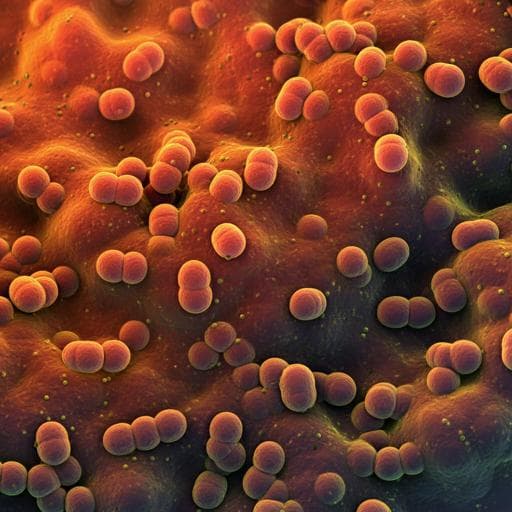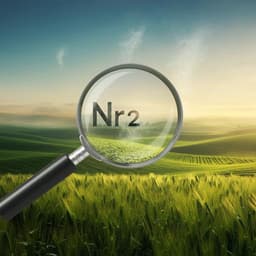
Agriculture
Nitrous oxide respiring bacteria in biogas digestates for reduced agricultural emissions
K. R. Jonassen, L. H. Hagen, et al.
Discover how researchers Kjell Rune Jonassen and colleagues are transforming agricultural practices by using nitrous oxide-respiring bacteria in biogas digestates. Their innovative approach not only reduces harmful N₂O emissions but also establishes a sustainable method to enhance soil microbiomes, paving the way for benefits in plant growth and bioremediation.
~3 min • Beginner • English
Introduction
Nitrous oxide (N₂O) is a potent greenhouse gas, with agricultural soils contributing about one-third of anthropogenic emissions. Heterotrophic denitrification is a major source of soil N₂O, but denitrifiers also act as sinks via nitrous oxide reductase (NosZ). Many organisms have truncated denitrification pathways, and organisms harboring nosZ alone (non-denitrifying N₂O-reducers) have been proposed as N₂O sinks. However, practical, scalable strategies to enhance soil N₂O-reducing capacity are lacking. The study hypothesizes that anaerobic digestate from biogas production can serve as both a substrate and vector to enrich and deliver N₂O-respiring bacteria (NRB) to soils via existing fertilization practices. The objectives are to (1) selectively enrich digestate-adapted NRB under N₂O, (2) isolate and characterize key NRB and their regulatory traits, and (3) test whether NRB-enriched digestates reduce soil N₂O emissions under controlled conditions.
Literature Review
Background work highlights: (1) Global and agricultural contributions to N₂O emissions and the limitations of agronomic measures alone to reduce emissions; (2) Denitrification pathways (nar/nap, nir, nor, nosZ) and regulation by oxygen, with emphasis on organisms with truncated pathways acting as N₂O sources or sinks; (3) Prior demonstrations that inoculating soils with nosZ-only bacteria reduces N₂O emissions but is impractical at scale; (4) Anaerobic digestion (AD) as a growing technology producing nutrient-rich digestates potentially suitable for microbiome engineering; (5) Evidence that pH impairs synthesis of functional Nos but not its activity once formed; (6) Mixed findings on the comparative kinetics of NosZ clade I vs clade II organisms, suggesting both ecological and kinetic determinants of N₂O reduction efficiency.
Methodology
Digestate sources: Mesophilic (37 °C) and thermophilic (52 °C) anaerobic digesters processing precipitated municipal wastewater sludge (organic matter 5.6% w/w). Digestates contained ~2.1% organic matter, 1.8–1.9 g NH₄⁺-N L⁻¹, 16–32 meq VFA L⁻¹, pH 7.6–8.2. Digestates were transported and used within 3–6 h.
Gas-kinetics platform: Robotized incubation system with 30 parallel stirred 120 mL serum vial batches monitored for headspace O₂, N₂, N₂O, NO, CO₂, CH₄. Sampling losses corrected to compute gas production/consumption rates.
Enrichment culturing: 50 mL digestate per vial, headspace flushed with He and supplemented with N₂O; N₂O replenished upon depletion. Cultures stirred (300 rpm) at 20 °C. Liquid samples taken for metagenomics, metaproteomics, VFA and 16S rRNA gene quantification. Growth of NRB modeled from N₂O-to-N₂ kinetics.
Comparative incubations: Parallel digestate incubations with O₂ or NO₃⁻ as electron acceptors to assess impacts on methanogenesis and to estimate abundances of O₂-, NO₃⁻-, and N₂O-respiring populations.
Meta-omics: Illumina HiSeq4000 sequencing; assembly and binning yielded 278 MAGs (149 with completeness >50% and contamination <20%). Proteins extracted and analyzed by nanoLC-MS/MS; metaproteome searches against MAGs database. NosZ and other denitrification proteins tracked over time.
Isolation of NRB: Enrichment culture dilutions plated on varied media, incubated anaerobically with N₂O. Colonies re-streaked and cultured aerobically; 16S sequencing. Three isolates selected: PS (Pseudomonas sp.), AS (Azospira sp.), AN (Azonexus sp.).
Genome sequencing and phenotyping of isolates: Whole-genome sequencing; ANI comparisons to MAGs; Biolog PM1/PM2 carbon utilization profiles; denitrification phenotyping via batch cultures tracking O₂, NO₂⁻, NO, N₂O, N₂ kinetics through oxic-anoxic transition. Proteomic quantification of reductases to assess bet-hedging (distribution of Nap/Nar, Nir, Nos across cells).
Soil mitigation experiments: Microcosms (10 g soil) amended with 3 mL digestate treatments: (i) live digestate, (ii) digestate heated 70 °C for 2 h, (iii) autoclaved digestate with aerobically grown isolates (PS, AS, AN), (iv) PS-grown digestate subsequently heated (PS_70 °C control), and (v) digestate enriched anaerobically with N₂O reducers. Incubated with He + 0.5% O₂, monitoring O₂, NO, N₂O, N₂; two soils differing in pH (pHCaCl2 5.5 and 6.6). Calculated N₂O-index (IN2O) up to 40% and 100% recovery of NO₃⁻-N as N gases. Additional tests assessed persistence after 70 h aerobic storage.
Key Findings
- Indigenous NRB in digestates were selectively enriched under N₂O at 20 °C. Modeled growing population increased from ~2.5×10³ to 1.6×10⁸ cells mL⁻¹ by 110 h, reaching ~3×10⁹ cells mL⁻¹ by 215 h; specific growth rate µ ≈ 0.1 h⁻¹. Cell-specific electron flow during exponential growth was ~5 fmol e⁻ cell⁻¹ h⁻¹, declining as populations increased.
- Methanogenesis was inhibited by N₂O and recovered during N₂O depletion; O₂ partially inhibited methanogenesis and NO₃⁻ fully inhibited it. Early enrichment phases showed transient accumulation of H₂ and VFAs consistent with methanogenesis inhibition and subsequent consumption by NRB.
- Meta-omics identified 149 quality MAGs; most remained stable, with MAG260 (Dechloromonas-like) and MAG268 increasing markedly. NosZ proteins detected from five nosZ-containing MAGs; only Nos was detected among denitrification enzymes during enrichment. MAG260 accounted for ~92% of detectable Nos at final time point and encoded Nap (not Nar), suggesting preferential electron flow to N₂O over NO₃⁻.
- Three isolates obtained: PS (Pseudomonas; nosZ clade I; Nar), AN (Azonexus; nosZ clade II; Nap; 98.2% ANI to MAG260), AS (Azospira; nosZ clade II; Nap). PS had broad carbon utilization; AN and AS specialized on small VFAs and TCA intermediates.
- Denitrification phenotypes indicated bet-hedging: PS resembled Paracoccus denitrificans with Nos expression across cells and Nir in a minority, maintaining very low N₂O even with NO₂⁻ present. AN and AS preferentially reduced N₂O over NO₃⁻ (linked to Nap) but not over NO₂⁻; proteomics of AN showed high Nos/Nap ratio (~25) early in denitrification.
- Soil microcosms: Digestate enriched with NRB under N₂O produced extremely low IN2O values in both acidic (pH 5.5) and near-neutral (pH 6.6) soils, indicating strong N₂O sink activity carried over from enrichment. Treatments with isolates (PS, AN, AS) significantly reduced IN2O versus the matched heat-killed control (PS_70 °C). PS yielded very low IN2O at both pH levels, indicating robust Nos synthesis at low pH; AN and AS showed higher IN2O in acidic soil, consistent with impaired Nos synthesis at low pH.
- Methane monitoring in soil showed CH₄ production when live or N₂O-enriched digestates were used (methanogens intact), but no CH₄ after heat treatment or autoclaving, supporting sanitation to prevent CH₄ emissions.
- Effects persisted after 70 h aerobic storage, indicating robustness. Statistical analyses showed significant effects of digestate treatment, soil pH, and their interaction on IN2O (p < 0.001).
Discussion
The study demonstrates a feasible, scalable route to deploy N₂O-respiring bacteria to soils by leveraging anaerobic digestates as both growth substrates and delivery vectors. Under N₂O, digestate communities supplied fermentation intermediates (VFAs, H₂, acetate) that enabled rapid growth of NRB, while N₂O inhibited methanogenesis and redirected electron donors to NRB. Dominance of a Dechloromonas-like population (MAG260/AN) with Nap suggests a metabolic advantage in prioritizing N₂O reduction over NO₃⁻. Isolate phenotypes revealed regulatory strategies (bet-hedging) that confer strong N₂O sink capacity, particularly in PS, which maintained low N₂O even with NO₂⁻ present. Soil experiments confirmed that NRB-enriched digestates and digestates inoculated with select isolates reduce N₂O emissions across soil pH, with PS performing robustly under acidic conditions. The approach integrates seamlessly with biogas production workflows and could markedly enhance soil N₂O-reducing capacity during denitrification hot moments. Practical considerations include sanitizing digestates to prevent CH₄ emissions and selecting organisms with broad catabolic capacities and pH tolerance for longer-term soil survival and function.
Conclusion
Digestates from anaerobic digestion can be transformed into effective agents for mitigating soil N₂O emissions by enriching or inoculating them with N₂O-respiring bacteria. Meta-omics and gas kinetics showed that NRB exploit fermentation intermediates in digestates under N₂O and that select taxa (e.g., Dechloromonas-like, Pseudomonas sp.) can act as strong N₂O sinks due to metabolic and regulatory traits. Soil microcosm tests confirmed significant reductions in N₂O emission metrics, including under acidic conditions. The strategy is low-cost and scalable as an add-on to existing biogas infrastructure. Future work should refine enrichment protocols, perform long-term storage and field trials, and select consortia with broad substrate utilization, pH resilience, and potential co-benefits such as plant growth promotion or pollutant degradation.
Limitations
- Field validation is lacking; results are from lab-scale microcosms.
- Soil pH can impair de novo Nos synthesis; isolates AN and AS were less effective in acidic soil unless Nos was pre-expressed.
- Live digestates can introduce methanogens, leading to CH₄ emissions unless sanitized; sanitation steps are necessary and may affect microbial survival.
- nosZ-only organisms did not enrich under the conditions used; enriched NRB carried complete denitrification pathways, potentially producing N₂O under some conditions (e.g., with NO₂⁻ for AN/AS).
- Digestate microbial compositions vary with feedstock and AD configuration, leading to variable baseline N₂O effects and competition with indigenous O₂/NO₃⁻ respirers when growing isolates.
- Enrichment under N₂O at scale could be resource-intensive; the proposed alternative (aerobic growth of isolates in sanitized digestate) requires careful selection to ensure soil competitiveness and persistence.
Related Publications
Explore these studies to deepen your understanding of the subject.







